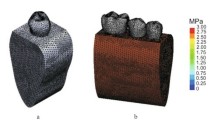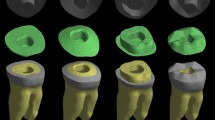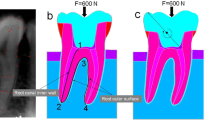Abstract
The purpose of this study was to compare the effect of ferrule with different heights on the stress distribution of dentin and the restoration-tooth complex, using the finite element stress analysis method. Three-dimensional finite element models simulating an endodontically treated maxillary central incisor restored with an all-ceramic crown were prepared. Three-dimensional models were varied in their ferrule height (NF: no ferrule, 1F: 1-mm ferrule, and 2F: 2-mm ferrule). A 300-N static occlusal load was applied to the palatal surface of the crown with a 135° angle to the long axis of the tooth. In addition, two post and core materials with different elastic modulus were evaluated. The differences in stress transfer characteristics of the models were analyzed. Maximum stresses were concentrated on force application areas (32.6–32.8 MPa). The stress values observed with the use of a 2-mm ferrule (14.1/16.8 MPa) were lower than the no-ferrule design (14.9/17.1 MPa) for both the glass fiber-reinforced and zirconium oxide ceramic post systems, respectively. The stress values observed with zirconium oxide ceramic were higher than that of glass fiber-reinforced post system. The use of a ferrule in endodontically treated teeth restored with an all-ceramic post-and-core reduces the values of von Mises stresses on tooth-restoration complex. At rigid zirconium oxide ceramic post system, stress levels, both at dentin wall and within the post, were higher than that of fiber posts.






Similar content being viewed by others
References
Akça K, Iplikçioğlu H (2001) Finite element stress analysis of the influence of staggered versus straight placement of dental implants. Int J Oral Maxillofac Implants 16:722–730
Asmussen E, Peutzfeldt A, Sahafi A (2005) Finite element analysis of stresses in endodontically treated, dowel-restored teeth. J Prosthet Dent 94:321–329
Assif D, Bitenski A, Pilo R, Oren E (1993) Effect of post design on resistance fracture of endodontically treated teeth with complete crowns. J Prosthet Dent 69:36–40
Assif D, Oren E, Marshak BL, Aviv I (1989) Photoelastic analysis of stress transfer by endodontically treated teeth to the supporting structure using different restorative materials. J Prosthet Dent 61:535–543
Ausiello P, Apicella A, Davidson CL (2002) Effect of adhesive layer properties on stress distribution in composite restorations—a 3D finite element analysis. Dent Mater 18:295–303
Beer FP, Johnston R (1993) Chapter 6: transformations of stress and strain, mechanics of materials. 2nd SI Metric ed. Singapore: McGraw-Hill International Editions, pp 367–369
Boschian Pest L, Guidotti S, Pietrabissa R, Gagliani M (2006) Stress distribution in a post-restored tooth using the three-dimensional finite element method. J Oral Rehabil 33:690–697
Chen J, Xu L (1994) A finite element analysis of the human temporomandibular joint. J Biomech Eng 116:401–407
Christel P, Meunier A, Heller M, Torre JP, Peille CN (1989) Mechanical properties and short-term in-vivo evaluation of yttrium-oxide-partially-stabilized zirconia. J Biomed Mater Res 23:45–61
Eraslan O, Sevimay M, Usumez A, Eskitascıoğlu G (2005) Effects of cantilever design and material on stress distribution in fixed partial dentures—a finite element analysis. J Oral Rehab 32:273–278
Eskitascioglu G, Belli S, Kalkan M (2002) Evaluation of two post core systems using two different methods (fracture strength test and a finite elemental stress analysis). J Endod 28:629–633
Eskitascioglu G, Usumez A, Sevimay M, Soykan E, Unsal E (2004) The influence of occlusal loading location on stresses transferred to implant-supported prostheses and supporting bone: A three-dimensional finite element study. J Prosthet Dent 91:144–150
Isıdor F, Brondum K, Ravnholt G (1999) The influence of post length and crown ferrule length on the resistance to cyclic loading of bovine teeth with prefabricated titanium posts. Int J Prosthodont 12:78–82
Kishen A (2006) Mechanisms and risk factors for fracture predilection in endodontically treated teeth. Endodontic Topics 13:57–83
Ko CC, Chu CS, Chung KH, Lee MC (1992) Effects of posts on dentin stress distributions in pulpless teeth. J Prosthet Dent 68:421–427
Loney RW, Kotowicz WE, McDowell GC (1990) Three-dimensional photoelastic stress analysis of the ferrule effect in cast post and cores. J Prosthet Dent 63:506–512
Magne P, Perakis N (2002) Stress distribution of inlay-anchored adhesive fixed partial dentures: A finite element analysis of the influence of restorative materials and abutment preparation design. J Prosthet Dent 87:516–527
Magne P, Versluis A, Douglas WH (1999) Rationalization of incisor shape: experimental-numerical analysis. J Prosthet Dent 81:345–355
Pegoretti A, Fambri L, Zappini G, Bianchetti M (2002) Finite element analysis of a glass fibre reinforced composite endodontic post. Biomaterials 23:2667–2682
Pereira JR, de Ornelas F, Conti PC, do Valle AL (2006) Effect of a crown ferrule on the fracture resistance of endodontically treated teeth restored with prefabricated posts. J Prosthet Dent 95:50–54
Pierrisnard L, Bohin F, Renault P, Barquins M (2002) Corono-radicular reconstruction of pulpless teeth: a mechanical study using finite element analysis. J Prosthet Dent 88:442–448
Reinhardt RA, Krejci RF, Pao YC, Stannard JG (1983) Dentin stresses in post-reconstructed teeth with diminishing bone support. J Dent Res 62:1002–1008
Sahafi A, Peutzfeldt A, Ravnholt G, Asmussen E, Gotfredsen K (2005) Resistance to cyclic loading of teeth restored with posts. Clin Oral Investig 9:84–90
Tada S, Stegaroiu R, Kitamurs E, Miyakawa O, Kusakari H (2003) Influence of implant design and bone quality on stress/strain distribution in bone around implants: a 3-dimensional finite element analysis. Int J Oral Maxillofac Implants 18:357–368
Timoshenko S, Young DH (1968) Elements of strength of materials, 5th edn. Wadsworth, Florence, p 377
Ugural AC, Fenster SK (1995) Criteria for material failure, Advanced Strength and Applied Elasticity, 3rd edn. Prentice-Hall PTR, New Jersey, pp 155–157
Weinstein AM, Klawitter JJ, Cook SD (1980) Implant–bone interface characteristic of bioglass dental implants. J Biomed Mater Res 14:23–29
Wheeler RC (2003) Wheeler’s dental anatomy, physiology, and occlusion, 8th edn. Saunders, St. Louis, p 154
Yang HS, Lang LA, Molina A, Felton DA (2001) The effects of dowel design and load direction on dowel-and-core restorations. J Prosthet Dent 85:558–567
Zarone F, Sorrentino R, Apicella D, Valentino B, Ferrari M, Aversa R, Apicella A (2006) Evaluation of the biomechanical behavior of maxillary central incisors restored by means of endocrowns compared to a natural tooth: a 3D static linear finite elements analysis. Dent Mater 22:1035–1044
Zhi-Yue L, Yu-**ng Z (2003) Effects of post–core design and ferrule on fracture resistance of endodontically treated maxillary central incisors. J Prosthet Dent 89:368–373
Conflict of interest statement
This study is funded by Research Projects Counsil of University of Selcuk. The authors declare that they have no financial and personal relationships with other people or organizations.
Author information
Authors and Affiliations
Corresponding author
Rights and permissions
About this article
Cite this article
Eraslan, O., Aykent, F., Yücel, M.T. et al. The finite element analysis of the effect of ferrule height on stress distribution at post-and-core-restored all-ceramic anterior crowns. Clin Oral Invest 13, 223–227 (2009). https://doi.org/10.1007/s00784-008-0217-5
Received:
Accepted:
Published:
Issue Date:
DOI: https://doi.org/10.1007/s00784-008-0217-5




